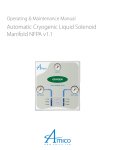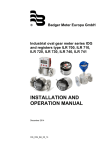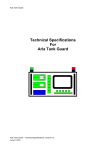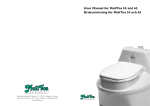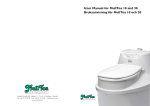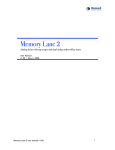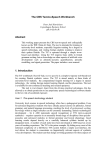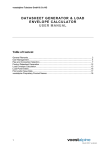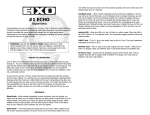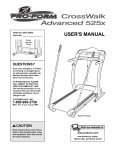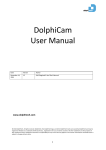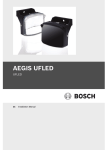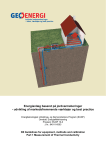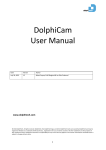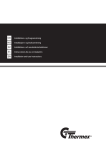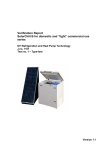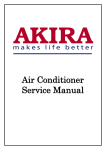Download Technical Specification For Arla Tankvagt
Transcript
Arla Tankvagt Technical Specification For Arla Tankvagt Tankvagt - technical specifications ver. 4.2 18 October 2006 Arla Tankvagt CONTENT 1 DOCUMENT CONTROL ........................................................................................................2 1.1 Revision History ....................................................................................................................2 1.2 Reviewers .............................................................................................................................2 1.3 Related Documents ..............................................................................................................2 2 INTRODUCTION....................................................................................................................3 2.1 Purpose and objective ..........................................................................................................3 2.2 Definition...............................................................................................................................3 2.3 Users ....................................................................................................................................3 Arla Farmer ....................................................................................................................................3 Arla Driver ......................................................................................................................................3 Arla Staff ........................................................................................................................................3 2.4 Arla Foods’ requirements for storage of milk ........................................................................3 2.5 Dictionary ..............................................................................................................................3 3 SPECIFICATION....................................................................................................................4 3.1 Schematic system setup .......................................................................................................4 3.2 Construction..........................................................................................................................4 General ..........................................................................................................................................4 Materiel ..........................................................................................................................................5 Display ...........................................................................................................................................5 Red and green lamp.......................................................................................................................5 Integration of the Tankvagt into a controller...................................................................................5 3.3 Interfaces ..............................................................................................................................5 3.4 External units ........................................................................................................................5 3.5 Events ...................................................................................................................................6 3.6 Phases ..................................................................................................................................7 3.7 Alarms...................................................................................................................................7 Critical and instructive alarm ..........................................................................................................9 Enable/disable alarm......................................................................................................................9 Critical alarm’s accepted status .....................................................................................................9 Clearing of alarms ..........................................................................................................................9 Operation of red and green lamp ...................................................................................................9 3.8 User interface .....................................................................................................................10 Main menu ...................................................................................................................................10 Alarm text in display .....................................................................................................................10 List of critical alarms.....................................................................................................................10 List of all alarms ...........................................................................................................................11 3.9 Configuration ......................................................................................................................11 3.10 Communication Tankvagt PC .............................................................................................11 3.11 Registration, Tankvagt <- > PC communication .................................................................11 General ........................................................................................................................................11 Requirements to CSV file.............................................................................................................12 Operation phase registration........................................................................................................12 Wash phase registration ..............................................................................................................12 Alarm and Events registration ......................................................................................................12 Connecting to the Tankvagt .........................................................................................................13 3.12 User Manual for Arla Farmer ..............................................................................................13 3.13 User Manual for the Arla Driver ..........................................................................................14 4 EXTEND TANKVAGT ..........................................................................................................14 5 APPENDIX ...........................................................................................................................15 5.1 List of examples ..................................................................................................................15 5.2 Performance test ................................................................................................................16 Tankvagt - technical specifications ver. 4.2 18 October 2006 Page 1 Arla Tankvagt 1 1.1 DOCUMENT CONTROL Revision History Version … 3.5 12.03.2004 3.6 23.03.2004 3.7 3.8 31.03.2004 11.01.2005 3.9 4.0 14.1.2005 Dec. 2005 4.1 4.11 01.10.2006 11.10.2006 4.2 18.10.2006 1.2 Date Change description Create document BCD-code error and communication plug added, revision record incl. Length of header is changed from 18d to 14d on page 36. Pin connection in plug Changes on page 18 regarding Instructive and critical alarms. Agitation time p15 = 30 min Comprehensive change and more explicit formulation. Basic “Arla Tankvagt” Basic “Arla Tankvagt” 3.11 Registration and 5.2 Performance test Extend “Arla Tankvagt” 4. Requirement for future functionality Team review PENJ PENJ PENJ PENJ/AHC/HSK AHC AHC and BEL PSP PSP AHC/LKM LKM/POKL PSP/POKL AHC/LKM Reviewers Name Preben Skov Pedersen Alex Hyldal Christensen Eskil Nilsson Poul Klemmensen Leif K Mortensen 1.3 Author Position Project Manager Farmer Adviser Farmer Adviser IT specialist IT specialist Related Documents Name of Document Quality Program “Arlagården” Tankvagt - technical specifications ver. 4.2 18 October 2006 Page 2 Arla Tankvagt 2 2.1 INTRODUCTION Purpose and objective The purpose of the Tankvagt is for the milk supplier and the dairy to monitor, make visible and document the storage conditions of the milk in the Arla Farmers milk-cooling tank to contribute to keeping the high quality of the milk. The object of this document is to specify the minimum Arla Foods requirements laid down for the Tankvagt, thereby providing a uniform basis for potential suppliers of Tankvagt to quote, sell, install and maintain the Tankvagt. 2.2 Definition A Tankvagt is a computer unit mounted on or at the farmer’s milk cooling tank to: • Register conditions and events concerning the milk-cooling tank. • Clearly indicate whether the working conditions of the milk-cooling tank are not or have not been optimum. • Assist the user in assuring that the milk is kept at the optimum conditions. • Assist the farmer in minimizing the costs of failure of the storage equipment. The Tankvagt shall be regarded as a fully automatic computer unit, which under normal conditions shall not be operated. 2.3 Users The following lists persons and groups in relation to Arla Foods who can be users of a Tankvagt: Arla Farmer The person(s) who owns or/and works at the farm producing the milk kept in the milk-cooling tank. The Arla Farmer will use the Tankvagt on a daily basis. The Arla Farmer has the fully responsibility of the milk from milking to collection. Arla Driver The tank driver visiting the Arla Farmer for collecting the milk from the cooling tank. The Arla Driver will use the Tankvagt at every collection. The Arla Driver must follow the present instruction for collecting milk. Arla Staff Service personal visiting the Arla Farmer for e.g. controlling equipment in the milk room. 2.4 Arla Foods’ requirements for storage of milk Requirement for storage of milk at the Arla Farmer can be found in the document “Arlagården” (the Arla Farm). 2.5 Dictionary Word Agitator CIP-system Description Typically, an electric motor with shaft and blade mounted on the milk-cooling tank keeping the milk mixed. A system for cleaning the milk-cooling tank. Tankvagt - technical specifications ver. 4.2 18 October 2006 Page 3 Arla Tankvagt Word Conductivity sensor Temperature sensor 3 3.1 Description Sensor measuring the conductivity (mS/cm) in the wash water used during CIP. Sensor measuring the temperature of the milk in the cooling tank. SPECIFICATION Schematic system setup The below figure illustrates the total system setup containing the milk-cooling tank, Tankvagt, data-connection, and PC. Item 3 includes a general specification of the “Basic Tankvagt” and item 4 contains the addition for “Extend Tankvagt”. 3.2 Construction General The Arla Tankvagt must be constructed so as to be suitable for installation on or within easy reach of the farmer’s milk-cooling tank in the milk room. It is the producer’s responsibility that the Tankvagt is produced and installed according to national legislation in the country of application. In this connection it is required that there is a Tankvagt - technical specifications ver. 4.2 18 October 2006 Page 4 Arla Tankvagt declaration of conformity stating that the product is CE-marked and that the national legislation in relation to the EMC, the low voltage directive etc. are observed. Materiel The Tankvagt must be constructed in plastic material or in stainless steel since it is the producer’s responsibility that the Tankvagt stands the tough environment in the milk room as to the climatic, cleaning and service conditions. Display The Tankvagt must be equipped with a display, which is large enough to show the information mentioned in this document (minimum 48 characters). The text size must be presented in 5 mm height. The display must be readable in the bright sunlight and dark. Red and green lamp The Tankvagt must be equipped with a red and a green lamp, and it must be evident for the user, which one is turned on. If the lamps are placed externally, the connection to the Tankvagt must be visible. Integration of the Tankvagt into a controller The Tankvagt may be integrated into a controller of the milk cooling tank which operates or controls the cooling, CIP, agitation, etc. If a milk cooling tank with the Tankvagt integrated into the controller is chosen, it is however required that registration, measuring, displaying and data communication take place as if it were a separate Tankvagt. Redundant sensors are not required. 3.3 Interfaces The Tankvagt must via interfaces be able to connect to external units for monitoring or receiving data. The Tankvagt must have the following interfaces: Interface Temperature interface Description For connection to a temperature sensor. Agitator interface For connection to agitator. CIP-interface For connection to CIP-system used for washing the milk-cooling tank. For connection to a unit measuring the milk quantity in the tank. Milk quantity interface Conductivity interface For connection to sensor measuring the conductivity of the wash water used during wash of tank. Communication interface For connection to a GPRS modem requirement in Extend Tankvagt. First-milk-in-tank face PC interface 3.4 inter- For connection to equipment given signal when the first milk goes into the tank after it has been emptied and washed. Data from Tankvagt must be transmitted to PC via standard interface in Common Separated Value (CSV) file format. External units The Tankvagt must via the interfaces be connected to the following external units: Tankvagt - technical specifications ver. 4.2 18 October 2006 Page 5 Arla Tankvagt External unit Temperature sensor Description Interface Temperature Specification must be: • Range of measuring -10 to +80°C at Interface least • Resolution 0.1°C at least • Accuracy of measurement +/- 0.2°C at least Agitator Signal telling if agitator is running or stopped. CIP-system Signal telling if CIP-system is running or stopped. Standard PC The Tankvagt must receive 60 days’ data in CSV file format. Unit monitoring when the Method is free for detecting when the first first milk goes into the milk goes into the tank. tank after wash of tank. Conductivity sensor Limit value for x1 mS/cm and x2 mS/cm Agitator interface CIP-interface Standard PC interface First milk in tank interface Conductivity interface The connection may be direct e.g. with a connection to the temperature sensor, or indirect e.g. with a connection to a controller and then connected to the temperature sensor. In the present version of the Tankvagt it is not a requirement that interfaces not listed in the above table are connected to external units. 3.5 Events An event is an “outside” action, which happened not in control of the Tankvagt. The Tankvagt must detect the following events: Event First milk in tank When does it happen? When the first milk goes into the milk-cooling tank after it has been emptied and washed. Agitation start When agitation unit is activated / started. Tankvagt - technical specifications ver. 4.2 18 October 2006 Page 6 Arla Tankvagt Event Agitation stop When does it happen? When agitation unit is deactivated / stopped. Wash start When CIP-system is activated / started. Wash stop When CIP-system is deactivated / stopped. Power turned on Power supply to the Tankvagt goes from off / disconnected to on / connected. Power turned off Power supply to the Tankvagt goes from on / connected to off / disconnected. 3.6 Phases The Tankvagt must have different phases to operate in. When a phase is “on” it is in this context called active. Only one phase can be active at a time, and one phase must always be active at any time. At the moment, once a new phase gets active, the prior phase gets not active. The Tankvagt must have the following phases: Phase Description Active – when? OperationThe phase is active when the milk- The operational phase must get phase cooling tank contains milk. active when the pause phase is active, and the event first milk in tank happens. Wash-phase The phase is active when the cooling The wash-phase must get active tank is washed. when the event start happens. Pause-phase The phase is active when the cooling The pause-phase must get active tank is empty and in stand-by. when the event wash stop happens. 3.7 Alarms The Tankvagt must be able to give an alarm. Be every alarm an alarm text is shown in the display of the Tankvagt. Besides this alarm text there must also be a red or green warning lamp. As an option to these two warning signals, the Tankvagt must also be prepared to install an external acoustic alarm- Interface to this is 2 terminals. The Tankvagt can only give an alarm when the specified phase for the given alarm is active. When an alarm is given, it is said to be “on”, otherwise it is “off”. The following lists the alarms, which the Tankvagt must handle: Alarm Alarm name No. 1 Temperature high Phase Triggered – when? Operation Milk temperature is x °C Alarm 1: or above for more than y Milk temperature consecutive hours. higher than x °C for y minutes. Tankvagt - technical specifications ver. 4.2 18 October 2006 Alarm text Page 7 Arla Tankvagt Alarm Alarm name No. Phase Triggered – when? 2 Agitation failure Operation Agitation of the milk has Alarm 2: not been done for x con- Agitation failure for x minutes. secutive minutes. 3 Power or hardware Operation and The power to the Tankfailure Wash vagt has been disconnected or not supplied for more than x consecutive minutes or hardware failure. 4 Temperature high Operation Milk temperature is x °C Alarm 4: temperature or above for more than y Milk higher than x °C for consecutive hours. y minutes. 5 Agitation failure Operation Agitation of the milk has Alarm 5: not been done for x con- Agitation failure for secutive minutes. x minutes. 6 Wash temperature Wash Wash temperature x °C Alarm 6: has not been reached Wash temperature during the wash phase. x °C has not been reached. 7 Wash time 8 Conductivity temperature- Wash Wash temperature has not been above x °C in y minutes during the wash phase. Alarm text Alarm 3: Power disconnected for more than x minutes. Or Tankvagt failure. Alarm 7: Wash temperature not above x °C in y minutes. Wash Conductivity x mS/cm Alarm 8: has not been reached Conductivity x during the wash phase. mS/cm not reached. “x” and “y” in the above table are variables and do not have the same value from one alarm to another. The above alarm text must be translated into local language according the following: Alarm Swedish Danish No. 1 Alarm 1. Mjölktemperaturen över x°C i y Alarm 1. Mælketemperatur over x °C i y miminuter. nutter. 2 Alarm 2. Omrörning uteblivit i x minuter. Alarm 2. Omrøring udeblevet i x minutter. 3 4 5 6 7 Alarm 3. Strömavbrott i minst x minuter. Eller tankvagt fail. Alarm 4. Mjölktemperaturen över x°C i y minuter. Alarm 5. Omrörning uteblivit i x minuter. Alarm 3. Strømafbrud i min. x minutter. Eller tankvagt fejl. Alarm 4. Mælketemperatur over x °C i y minutter. Alarm 5. Omrøring udeblevet i x minutter. Alarm 6. Disktemperaturen x°C har inte Alarm 6. Vasketemperatur x °C ikke nået. uppnåtts. Alarm 7. Disktemperaturen inte över Alarm 7. Vasketemperatur ikke over x °C i y Tankvagt - technical specifications ver. 4.2 18 October 2006 Page 8 Arla Tankvagt Alarm No. Swedish Danish x°C i y minuter. minutter. 8 Alarm 8. Ledningsförmågan x mS/cm Alarm 8. Ledningsevne x mS/cm ikke ophar inte uppnåtts. nået. The Tankvagt must be able to operate with 3 different languages (UK, DK, SE). Critical and instructive alarm Two types of alarms must be available: Critical and instructive. A critical alarm must always and in all situations take precedence of an instructive alarm. Enable/disable alarm An alarm can be enabled or disabled. It can only be on when the alarm is enabled. When an alarm is enabled, it must be defined as critical or instructive. Critical alarm’s accepted status A critical alarm must have a status telling whether it has been accepted or not. When a critical alarm gets on it has an Accepted status No. When a user via the user interface accepts a critical alarm the Accepted status is changed to yes. To accept a critical alarm only a single or a few keystrokes must be used. Clearing of alarms An alarm must have a status telling whether it has been cleared or not. When an alarm gets on it has a cleared status No. When an alarm is cleared it changes the Cleared status to Yes, and it is then off. When an alarm is on it must be able to be cleared under the following conditions: Alarm type Critical alarm Instructive alarm Conditions for clearing Alarms from previous phases are cleared when the wash phase has been active for 10 minutes. Alarms, if any, from current wash phase must not be cleared. Alarms from previous phases are cleared when the wash-phase has been active for 10 minutes. Alarms, if any, from current wash phase must not be cleared. The alarm can also be cleared at any time via the user interface. Clearing of an alarm via the user interface must be done with a single or few keystrokes. Operation of red and green lamp The lamps must be able to light in the following ways: Lamp Description Turned No light in the lamp. off Solid The lamp is turned on. Flashing The lamp is turned off and turned on in frequency of approx. 1 sec. The following lists the different ways in which the lamps must light in relation to a given phase, alarm type and if a critical alarm is accepted. Tankvagt - technical specifications ver. 4.2 18 October 2006 Page 9 Arla Tankvagt Phase Operation Alarm type No alarm Accepted - Green lamp Solid Red lamp Turned off Operation Critical No Turned off Flashing Operation Critical Yes Turned off Solid Operation Instructive - Flashing Turned off Operation Critical and instructive No Flashing Flashing Operation Critical and instructive Yes Flashing Solid Wash No alarm - Turned off Turned off Wash Critical No Turned off Flashing Wash Critical Yes Turned off Solid Wash Instructive - Flashing Turned off Wash Critical and instructive No Flashing Flashing Wash Critical and instructive Yes Flashing Solid Pause - - Turned off Turned off Pause Critical No Turned off Flashing Pause Critical Yes Turned off Solid Pause Instructive - Flashing Turned off Pause Critical and instructive No Flashing Flashing Pause Critical and instructive Yes Flashing Solid 3.8 User interface The following part describes the requirements to the user interface. Main menu The Tankvagt must have a so-called “Main-menu” which can be shown in the display. Additional information must be shown in the Main menu, including: • Current local date and time • Current phase of the Tankvagt (operation, wash, pause) • Current temperature in the milk-cooling tank Alarm text in display When an alarm gets on, the Tankvagt must show the alarm text in the display. When accepted or cleared it is removed from the display and the Main menu is shown. List of critical alarms A list of all registrations of critical alarms not cleared must be able to be shown in the display. Tankvagt - technical specifications ver. 4.2 18 October 2006 Page 10 Arla Tankvagt To display the list only one key must be pressed. For each critical alarm the belonging alarm text and date / time of start of alarm must be shown in the display by pressing a single key. List of all alarms A list of all registrations of alarms must be able to be shown in display. To display the list only one key must be pressed. For each alarm the belonging alarm text and date / time of start of alarm must be shown in the display by pressing a single key. 3.9 Configuration The following areas must be configurative: Name Country code Farmer ID (9 digits) Tank number Tank guard ID (2 digits) Description The country where the Tankvagt is installed. Values are: DK, SE, UK… Farmer number Number of the milk-cooling tank at the farmer. The first tank has number 1, the second number 2… Tank guard supplier ID The configuration must be readable from the display of the Tankvagt. 3.10 Communication Tankvagt PC It must be possible for the Tankvagt to be connected to a PC for communicating data to and from the Tankvagt. All registrations (60 days) from the Tankvagt must be able to be downloaded to a PC within 10 minutes. A so-called “CSV”-file must be ready to send data from the Tankvagt to a PC with standard PC interface. The data string must be prepared as described in chapter 3.11 Registration. 3.11 Registration, Tankvagt <- > PC communication General The Tankvagt should be provided with an interface, which can communicate with a standard PC on a Windows XP platform. Via the interface the following data in CSV format are uploaded from the Tankvagt: • Analog values and Wash phase data are supplied in a CSV log • Alarm / event are supplied in another CSV log • The Tankvagt setup (set values) in a third CSV log. A registration must contain date and time information to be created. Once the Tankvagt has created a registration, the registration must not be changed. The registrations must be kept in the Tankvagt for 60 days in a buffer. The data must not be cleared via the user interface, or by switching off the power supply. It must be possible to store additional 20% data and extend the programmed by 20% without altering the Tankvagt /adding extra storage. Together with the Tankvagt a 2-meter cable (including interface) and necessary software should be supplied to read the CSV file in for instance MS Excel. The buyer and Arla Foods should Tankvagt - technical specifications ver. 4.2 18 October 2006 Page 11 Arla Tankvagt have the Software at their free disposal and the right for installation. All source codes to the software should be available unless specified otherwise in the quotation. Requirements to CSV file CSV file must be named in heater with the following heading: 123456789_xx_yy_zz.csv Where: 123456789: 9-figure Farmer ID xx: tank no. of the supplier yy: File log: AI (analog), AE (alarm/event), TO (Tankvagt values) zz: Tankvagt initials Operation phase registration A registration must be created at least 4 times per hour during the operation phase. • Temperature of milk 1/10 degree C • Tank volume contents in whole liters Wash phase registration A registration must be created at least 1 time per 1 minute during wash phase each registration to be logged with date and time. • Wash time • Time for wash started • Temperature during wash • Conductivity • Time for wash ended • Maximum temperature during wash (max. temperature in wash phase in 1/10 degrees C) • Actual wash time in minutes • Time where wash is not above the stated temperature, as defined in alarm 7 • Max conductivity in wash phase in 1/10 Ω –1 alarm 8 CSV file for Operation and Wash phase 123456789_01_AI_zz.csv Alarm and Events registration A registration must be created when an alarm gets on where. Each registration should be logged with date and time. Tankvagt - technical specifications ver. 4.2 18 October 2006 Page 12 Arla Tankvagt CSV file for Operation and Wash phase 123456789_01_AE_zz.csv Connecting to the Tankvagt In order to send and receive the configuration of the Tankvagt to the PC, a CSV file is defined with the following format: CSV file for Tank guard configuration 123456789_01_TO_zz.csv 3.12 User Manual for Arla Farmer Together with the Tankvagt a user manual for the Arla Farmer must follow. It must contain the following instructions: • How to get list of critical and instructive alarms to be shown in display, see Appendix • How to read the alarm text belonging to a critical or instructive alarm, see Appendix. • Tankvagt troubleshooting guide • Technical documentation and software cd The User Manual should be constructed with illustrations of the specific Tankvagt menu. The manual is supplied in an English, Danish and Swedish edition. Tankvagt - technical specifications ver. 4.2 18 October 2006 Page 13 Arla Tankvagt 3.13 User Manual for the Arla Driver Together with the Tankvagt a user manual for the Arla Driver must follow. The manual must be in one page and suitable for hanging on the wall in the milk room. It must contain the following instructions: • How to get List of critical alarms to be shown in the display. • How to read the alarm text belonging to a critical alarm. The User Manual should be constructed with illustrations of the specific Tankvagt menu. The manual is supplied in an English, Danish and Swedish edition. 4 Extend Tankvagt This section describes the requirements laid down for the Extend Tankvagt. The following figure shows the principle layout of the set-up. In the extended Tankvagt, it is required to equip the Tankvagt with a GSM and GPRS modem to communicate and transmit data in different ways. The following must be possible. 1. It must be possible for Arla or the buyer to use any mobile phone supplier and not limited to one specific. 2. The Tankvagt must be able to send SMS to up to 5 pre-defines mobile phone numbers. Phone numbers are entered and configured from the Tankvagt by use of the display and buttons (i.e. without a PC connected and without programming software available). In case of critical and non-critical alarms, the alarm message and information about the Tankvagt must be transmitted to the phone numbers entered. 3. It must be possible to dial up the GSM modem and request the data files as if it was connected to the Tankvagt by cable. 4. It must be possible to connect external antenna to the Tankvagt instead of the standard / build in antenna. 5. The GPRS modem must be able to send data to a central located server (located within Arla Foods). The central server is described by IP and it must be possible to turn on and off this functionality. a. Analogue measurements (as described in section 3.11, example of analogue registration) may be stored within the Tankvagt and send in packages to the central server. The maximum time between transmission of packages must be configurable (via programming tool) within the Tankvagt, besides this minimizing transmission costs most be taken into considerations. Analogue measurements are stored on the central server in CSV files according to description in section 3.11, with creation of one file pr. transmission. Files are then read and deleted when processed. Tankvagt - technical specifications ver. 4.2 18 October 2006 Page 14 Arla Tankvagt b. Events are treated as analogue measurements. c. Alarms must be transmitted to central server together with other transmissions and max within a certain configurable time delay (not the same as described above, and configured via programming tool). This data must be delivered to an OPC server installed on the central server and packed into one 16 bit register / integer pr. Tankvagt. d. On the OPC server, two Boolean tags must be defined to indicate connection status to the GPRS modem on the Tankvagt and to indicate connection status to the Tankvagt itself (if appropriate). It must be possible to monitor the status of each individual Tankvagt online. In order to fulfill the above, the buyer and Arla Foods should have the Software at free disposal and the right for installation. All source codes to the software should be available unless other conditions are specified in the quotation. 5 5.1 Appendix List of examples The following lists examples of users using the Tankvagt. Collection without critical alarm Task: Arla Driver collects milk from the milk-cooling tank Frequency: Every day or every second day. Sub task Arla Driver arrives to milk room and checks the Tankvagt. Arla Driver starts pumping the milk into the tanker and may hereafter start the CIPsystem. Tankvagt solution Green lamp is lighting or flashing. The Tankvagt clears automatically any instructive alarms. Collection with critical alarm Task: Arla Driver collects milk from the milk-cooling tank Frequency: Every day or every second day. Sub task Tankvagt solution Arla Driver arrives to milk room and checks Red lamp is lighting or flashing. the Tankvagt. Arla Driver controls the type of critical alarm. After pressing the “Critical alarm” key the Tankvagt shows a list of critical alarms and the belonging alarm text in the display. Arla Driver controls his procedure for critical alarm and reacts as described. Hereafter with the milk-cooling tank emptied The Tankvagt clears automatically all alarms. the CIP-system is started. Control with instructive alarm Task: Arla Farmer controls the Tankvagt Frequency: Every day, many times. Tankvagt - technical specifications ver. 4.2 18 October 2006 Page 15 Arla Tankvagt Sub task Arla Farmer arrives to milk room for checking the Tankvagt. Arla Farmer decides how to react and clears the instructive alarm. Tankvagt solution Green lamp is flashing and an alarm text is shown in the display. After pressing the “Clear alarm” key the green lamp stops flashing and turns to solid green. Control and collection with critical alarm Task: Arla Farmer controls the Tankvagt and Arla Driver collects milk Frequency: Every day or every second day. Sub task Arla Farmer arrives to milk room for checking the Tankvagt. Arla Farmer controls his procedure and reacts as described. Hereafter he “signs” for reading the critical alarm. Arla Driver arrives to milk room and checks the Tankvagt. Arla Driver controls the type of critical alarm. Tankvagt solution Red lamp is flashing and an alarm text is shown in the display. After pressing the “Accept critical alarm” key, the red lamp stops flashing and turns to solid red. Lamp is solid red. After pressing the “Critical alarm” key the Tankvagt shows in the display a list of critical alarms with belonging alarm text. Arla Driver controls his procedure for a critical alarm and reacts as described. Hereafter with the milk-cooling tank emptied The Tankvagt clears automatically all alarms. the CIP is started. 5.2 Performance test Located in speparate document. Tankvagt - technical specifications ver. 4.2 18 October 2006 Page 16

















